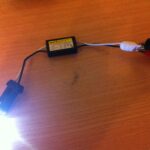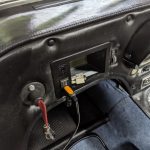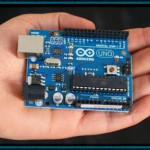Welcome to my digital home! There are lots of articles you might find helpful buried in this site on topics such as modifying an Alfa Romeo 159, rebuilding a Lotus 7 (Robin Hood 2B), not to mention a ton of stuff on technology in general. It’s all here somewhere, so use the search function or navigate using the menu structure. if you want to talk, reach out via the contact function, I usually do answer!
Random Post Selection
Alfa 159This post covers the exterior lighting modifications made to my 2008 Alfa Romeo 159 TI. If you are interested in the interior LED conversion guide, click here. This modification can be completed as a single project or as a series of smaller projects as the cost of components is still quite high due to some of the LED types in use. If you do choose to split the project I would suggest separating the turn signals / Indicators, Numberplate lights, sidelights and rear clusters into stand alone projects.
For an alternative approach to upgrade the “Third Brake Light” at position 9, click here to see the Cylon Project.
Each topic area is collapsed below for your ease of navigation so either “Show All” or Expand each sub-topic as needed:
The parts you need for this conversion are as follows:
4 x Type 380 (1157) RED 13-LED Superlux [BAY15D,380,1157,P21/5w] 12v (Positions 5,6,7&8)
1 x Type 382 CREE Q5 12V/24V HIGH POWER LED BULB for the reverse light (Position 8 )
1 x Type 382/P21W 5W CREE Q5 RED LED BULB for the fog light (Position 6)
2 x CANBUS Type 501/W5W/T10 24 LED Bulbs for the front side lights (Positions 1&2)
2 x CANBUS Type 501/W5W/T10 4 LED Bulbs for the numberplate lights (Position 10 )
4 x BAU15s 7507 Q5+12SMD=7W Brake/Signal Light 150° LED Bulbs Amber/Yellow PY21W for the front and rear indicators (Positions 1,2,5&7)
2 x 5 SMD LED AMBER ORANGE INDICATOR SIGNAL TURNING SIDE LIGHT BULB T10 W5W 501 for the side repeaters (Positions 3&4)
11 x 50w 10 ohm Aluminium clad wire wound resistors
2 x 25w 47 ohm Aluminium clad wire wound resistors
2 x 330 ohm 0.6w metal resistors
Lots of wire & plenty of heat shrink wrap
10 x Red Scotch clips
8 x Red 3mm male spade terminals
8 x Red 3mm female spade terminals
Estimated Cost: £170-200
Required Tools:
Soldering iron
Solder
Flux paste
Helping hands
Hot glue gun
Pro-Tip: You can remove the need to solder as well as reduce the overall effort if your prepared to increase your spend to buy the resistors pre-made from ebay. The example increase is DIY=£2 for a pair, whereas on ebay that would be £7-10 for the pair.
“CAN Bus”
Most modern cars make use of numerous computers within the vehicle all connected through something known as a Controller Area Network or “CAN Bus” for short. One of these computers is typically dedicated to looking after the internal electronics such as dials and gauges etc as well as the lighting circuits, in the Alfa its called the “Bodywork Computer” or “NBC” and one of its jobs is to make sure that if a bulb blows, you are warned when you get into the car with a friendly picture of your car and a warning symbol showing you which bulb has blown. This is a great feature, but unfortunately, it works against you when your swapping a traditional filament bulb for a new style LED replacement. The reason why is that a traditional bulb illuminates by putting a voltage across a metal element, essentially shorting out the circuit, causing it to heat up and emit light. This process creates a reasonably high load, measured in amps. LED bulbs work completely differently, essentially, they produce light by pushing electrons around inside a solid semi-conductor, which is a much more efficient process that creates significantly less load. This is where the problem comes! The bodywork computer puts a small amount of electricity on the bulb circuit to test that it has a connection and that the filament has not blown, so when you swap your old filament bulb for a LED one, you get one or two issues. The first issue is that the bodywork computer thinks the bulb has blown and lets you know, the second is that the small amount of power used to perform the test is actually enough to gently illuminate the LED, so it always stays on and never switches off, even when the ignition is off!
In order to fix this issue you need to use more power than you need to actually run the LED so you need to add resistance to the circuit to absorb and use extra power and simulate load. Exactly how much resistance you need is a mathematical calculation known as “ohms law” which takes a number of variables and tells you how much resistance, measured in ohms, you need to add. When you add resistance to a circuit it creates heat as the excess power is turned into heat energy to be dissipated. For this reason its important to make use of a large wattage resistor (wattage is the measure of a resistors heat dissipation ability) so that you don’t either burn out the component or even worse, create a fire hazard.
For each of the bulbs I have used, I have first measured the amps that the original filament bulb runs at, and then the amps that the replacement LED runs at to determine the correct resistor to add. For most of my replacement LEDs I have needed to simulate around 1.2amps of additional load, which was achieved using a 50w, 10 ohm aluminium wire wound resistor, however for the two side repeaters I only needed to simulate around 0.3 amps, so I used a 47 ohm, 25w aluminium wire wound resistor. In this case, because the ohms was higher and the load to simulate was lower, I was able to use a smaller wattage which reduced the actual size of the resistor.
As a point of note, every bulb in the 159 except the reverse light and the third brake light, has a CAN-BUS sensing circuit on it, and as such, will need to be replaced with a CAN-BUS capable LED or have additional resitors added to that circuit.
Front Clusters
The front clusters can be quite difficult to work with as, depending on your engine, there may not be much room to work. As mine is the 2.4 JTDM engine, I have the least amount of room so small hands, patients and a high tolerance for pain are required. The 24LED sidelights require a small modification to them before they are installed as, despite being sold as “CAN Bus friendly”, they do not simulate enough load for the Alfa to be happy with, as such, additional load, all be it a very small amount, is required. The modification requires the addition of a 330 ohm 0.6w resistor to each bulb so that when it is installed, the computer is happy that the bulb is not blown. I achieved this by soldering the LED directly onto the bulb as per the following images. Once the bulbs are ready to be installed, the next job is to prepare two of the 10 ohm 50w resistors for the front indicators. This is done by soldering around 6-8 inches of wire onto either terminal of the resistors, heat shrinking the exposed connections, and then putting scotch blocks on the end, ready to be attached to the wires inside the headlight.
The installation process is fiddly and generally very annoying but essentially for the sidelight, follow the eLearn guide below:
For the indicator, the following eLearn guide shows you how to change the bulb, however, in addition to this, you need to scotch clip the resistor to the two wires connecting to the bulb holder and place it somewhere inside the light unit once complete. In general I use a heat transfer sticky pad to affix the resistor to a suitable surface to stop it moving around:
Rear Clusters
The rear clusters are by far the most involved and require the most effort. They are split into two sections per side, one fixed to each wing (Potions 5&7) and two fixed to the boot lid (Positions 6&8). As each light unit contains a number of bulbs to replace its easier to make a “loom extension” that sits in between the original connector and the light unit and adds in the extra resistors in bulk for the bulbs. As such the light units at Positions 5 & 7 require 3 x 10 ohm , 50 w, aluminium wire wound resistors each, while the light unit at Position 6 requires 2 x10 ohm , 50 w, aluminium wire wound resistors and the light unit at Position 8 only requires 1 x10 ohm, 50 w, aluminium wire wound resistor.
For Position 8 it is easier to just scotch clip a single resistor into place over the “tail light” connection, as this is the only live circuit that makes use of a CAN Bus check signal. The Reverse Light does not have any CAN Bus checking (we will assume because you would notice!), and despite the type 1159 dual element stop/tail bulb being used in this position, only the tail element is wired up. I assume this was a “design feature” to save you carrying two different bulb types for the rear, although I find it quite stupid personally. Position 8 wiring is illustrated below:
Position 6 requires two resistors installing and as such its easier to build an extension for that connector than actually scotch clip them in place. The extension looks like the following and is attached to the shell of the car using heat transfer sticky pads for optimum heat dissipation into the vehicles shell:
These rear clusters are accessed for this upgrade as per the following guide:
Positions 5 & 7 are both the same with a three resistor unit required. The following images show the unit and the installation:
Whenever I have installed a loom extension I have coated the connections in hot glue so that they cannot come loose during driving conditions and I have used the sticky pads to secure the resistors on top of the metal surround for the light unit for optimal heat dissipation into the body shell..
The bulbs and loom extensions are then installed through the normal bulb change procedure:
Side Repeaters
The side repeaters have a limited amount of space to accommodate a bulb and as such the overall size of the bulb is an important factor. The chosen bulb is as large as the unit can house and also makes use of a multi-SMD architecture to provide a good directional light output. Aside from changing the bulb, additional resistance is needed to simulate the missing load of the original bulb. These resistors can be mounted in the engine bay, and cables run through the wing to join up with the side repeaters, where they can be scotch clipped to the existing wiring and then covered in ample amounts of insulation tape to avoid any moisture getting into the joins:
I used heat transfer sticky pads to stick the resistors to the top of the suspension pillars and ran the cable through the seem at the top of the wing down through to the side repeater hole for ease. This was a remarkably easy process and required only limited “fishing” for the cable.
Removal of the side repeater is a very simple process as per the following eLearn guide:
Number Plate Lights
The number plate LEDs are a simple swap of the original W5W type bulbs for the 4 LED versions. The 4 LED versions have been chosen for two primary reasons, firstly, I do not want it to be brighter than the original bulbs and secondly, the bulb housing do not have any built in reflectors, so its important to have the LEDs pointing the right way. The chosen bulbs satisfy these criteria well and provide a good light output. The upgrade is simple and the eLearn guide is below:
The finished product looks like this:
Third Brake Light
The third brake light employs a 10 x filament bulb light bar plugged into the back of the reflector unit, so to complete the LED conversion this is going to need to change. To do this, you will need to make a replacement bulb as no “off the shelf” direct replacements exist. I have built one called “The Cylon” which runs each LED individually and has some cool effects, but if you just want a simple LED replacement you can try the following approach. (warning, I have not done this so it needs verifying).
You will need to get 10 x 5mm round high power red LEDs with as wide a viewing angle as possible, like these, but do your own research to find the best ones you can. Once you have your LEDs you can use an on-line LED wizard to figure out the best way of wiring them up and what resistance you need to add. This will give you an output like this:
All you then need to do is remove the third brake light from the car, get out your soldering iron and hot glue your LEDs directly into the back of the reflector:
Once the glue is dry, make the connections as shown in the diagram, solder up all the parts and run about 18 inches of cable from the new unit to a “2 pin header row” that can be used to make a plug:
The completed unit can then be installed back into the car. There is no CAN Bus issues on this circuit so the light will just work like the original.
The complete/finished product is better displayed as a video and as such you can watch this one I made of the complete conversion:
Related Images: [...]
InfoSecI work in a world of standards, opinions, controls and countermeasures, all encompassed in a foreign language of “InfoSec” and “ItSec”. This of course, while entertaining, is of little use to the world. I would like to propose a simple concept, probably high level, and I am sure my peers would argue is “inadequate”, that said however, hear me out:
Ok, so the basic concept is simple, setup three primary work streams or “functions”, 1 is a Risk Asssesment and Classifcation Function, 2 is a People / Process/ Awareness, and 3 is Controls, both protective and detective as needed.
The idea is that the risk assessment process runs in a cycle with inputs and outputs at the core of the system which serves as the engine for security. Its easier to explain in a diagram, take a look:
Genious or Madness, its your decision, I like it because its simple and can be applied to any situation. Of course I agree with arguments such as “where is the governance?”, “what about strategy” etc, but quite simply, thats not what this is. This is a simple security process that allows you to feed information in and get solutions out.
Related Images: [...]
LiveMixesA fresh mix for you all – Happy New Year!
Track List:
Albin Myers – Time Like These
Robbie Rivera – New Direction
Oliver Twizt – Yo’re Not Alone
John Dahlback – More than I Wanted
Chris Lake – If You Knew
Doman & Gooding Feat Dru & Lincoln – Runnin
Guetta Angello Gerraud Ingrosso Willis – Everytime We Touch
Steve Angello & Laifdback Luke Feat Robin S – Show Me Love
Planet Funk – Lemonade
Kurd Maverick – Blue Monday
Nari & Milani Feat Max C – Disco Nuff
Kevin Bryant – Who You Wanna Be
Empire of the Sun – Walking on a Dream
https://jabawoki.com/wp-content/mp3/Jabawoki_Sunny_Side_Up_25012010.mp3
Podcast: Play in new window | Download
Related Images: [...]
RH2B Build DiaryIn the dash of the hoody was a previously installed large cubby holder. This had been damaged at some point and one of the previous owners had used a stick on faux leather pocket to hide the damage. As you can guess, this was not going to do for me and I thought I would put my 3d printer to good use and make something a little more useful!
Aside from the damaged cubby, I had a few cables dangling in the passenger foot well that I needed to do something with. Firstly I had the CTEK charge cable that I added for ease of keeping the battery tip top, then I had the ECU programming cable that I also needed to be able to easily access. Both of these needed a new home and they needed to be out of the way of a passengers feet!
CTEK Charge Point
The combination of broken plastic part + need to tidy cables & access to a 3D printer led me straight to Fusion 360 where I set about designing a new solution. The first design was an “all in one” unit that had to be printed with lots of supports and with the rear face on the bed. This left a less than desirable finish and was simply not going to do. This led me to my first “multi-part” design and print.
Utilizing Fusions component feature I was able to design the face and all parts that connect to it as separate objects that could then be printed individually. In total the final design had 4 parts. A face, a cubby, a light box and a lens. Yes, that’s right, I added LED’s 🙂 The idea was to have the Lotus Super 7 logo as well as the letters GBS (Great British Sportscars) cut through the face and an LED behind them so that it illuminated when the ignition was on.
Printed Parts for the final cubby
The face I decided to paint, which is a first for me, but I thought given it was on display and a large flat area, it could benefit from some paint. I used Plasti-Kote primer and black satin paint after some light sanding and the finish was truly impressive.
Once all the components were ready for assembly, I installed a small strip of 12v LED’s into the light box and painted the clear PLA diffuser lens in the same body paint that the car is painted in. This actually turned out better than I hoped for and was a very easy thing to do.
Light box and LEDs
The final product looks pretty cool and holds the parts I needed it to perfectly. Everything is neat and there is a more functional, better looking solution to a problem that was part my own doing and part legacy 🙂
Final Part Assembled
Related Images: [...]
LiveMixesIn honour of the legend that is Deadmau5 this mix is dedicated to his work and the awesome sounds that result from it.
01) Toca Me (Deadmau5 mix) – Fragma
02) I Want You (Deadmau5 mix) – Carl Cox
03) Afterhours – Deadmau5 & Mallefresh
04) Hey Baby – Deadmau5 & Mallefresh
05) Harder Better Faster on Drugs – Deadmau5 vs Daft Punk
06) Dont You Want To Feel (Deadmau5 mix) – Drugstore Era
07) Finished Symphony (Deadmau5 mix) – Hybrid
08) Tiny Dancer (Deadmau5 mix) – Marco Demark Feat Casey Barnes
09) Longest Road (Deadmau5 mix) – Morgan Page
10) Super Skunk (Deadmau5 mix) – Noir
11) Cherry Twist (Deadmau5 mix) – The Crystal Method
12) Dirty Sexy Club Music (Deadmau5 mix) – Filter Freq
13) Burn (Deadmau5 mix) – Prime 33
14) No Pressure (Deadmau5 mix) – One Plus One
15) God Is A DJ (Deadmau5 mix) – Faithless
https://jabawoki.com/wp-content/mp3/Jabawoki_Strictly_Mau5_04042011.mp3
Podcast: Play in new window | Download
Related Images: [...]
LiveMixesMore Progressive sounds for Easter…..
Fatboy Slim vs Koen Grownwvald – Rackafeller Skank (Original Mix)
Felix Baumgartner & Juan Kidd – Now Your Gone (Club Mix)
David Penn & Rober Gaez – Our Darkness (Original Mix)
Funkagenda – Breakwater (EDX Ibiza Sunrise Mix)
Milk & Sugar – Let the Sunshine (Milk & Sugar Global Mix)
Paul Gardner & Hugh Gunnell ft Marcella Woods – Come Get My Lovin (Plastik Funk Remix)
Faithless – Music Matters (Mark Knight Remix)
Sandy Rivera – Whatever (Andy Daniell Digital Edit)
Ou Est Le Swimming Pool – Dance The Way I Feel (Armand Van Helden Club Mix)
Richard Grey – One More Time (Chris Moody Remix)
Kim Fai – Good Life (Original Mix)
TV Rock – In the Air (Axwell Remix)
Young Rebels & Fransico Diaz – 1998 (Original Mix)
Funkagenda – Nobody Listens To Techno Feat. Mc Flipside (Original Mix)
Muzzaik – Going Underground (Original Mix)
DCA Project – Sandcastles (John Dahlback Remix)
Pryda – Waves (Original Mix)
Dankann – Genesis (Original Mix)
https://jabawoki.com/wp-content/mp3/Jabawoki_Easter_Progressive_06042010.mp3
Podcast: Play in new window | Download
Related Images: [...]
LiveMixesA multi-part Electro Pop Mix for the masses 🙂
01. David Guetta – Memories (Bingo Players Remix)
02. Klubbheads – Kickin hard (DJ Solovey Remix)
03. Desto – Crazy (Lindberg And William Remix)
04. Snap – The Power (DJ Pomeha Remix 2010)
05. Gubellini vs Pain feat Darook Mc – Shake It Up (Javi Mula Remix)
06. Sabien And Alim – Naughty Feat Jerique (Shahin Remix)
07. Loleatta Holloway – Ride On Time 2010 (Bruno Ramos & HytraxX Mix)
08. DJ Eako & Morelly feat. Omega Brown – I Can’t Stop (Steel Mix)
09. Queen – You Don’t Fool Me (Dj Denis Rublev & Dj Natasha Baccardi Remix 2010)
10. Andrea Paci feat. Michelle Weeks – Big Mama (Elektro Mix)
11. Crookers Feat. Miike Snow – Remedy (Magik Johnson Vocal Remix)
12. Axwell – I Found You (DJ MikeY 2010 Remix)
13. Robbie Rivera feat. Fast Eddie – Let Me Sip My Drink (Chuckie Remix)
14. Topmodelz – Have U Ever Been Mellow (Rekoilz Electro Remix)
15. Niels Van Gogh And Emilio Verdez – Black Is Black (Club Mix)
16. Soul Puncherz – Speakerz Bumpin Loud (Filthy Rehab Remix)
17. Shadow Stars – Desintegration feat. Sergei Khovanksy (Mario Ochoa Remix)
https://jabawoki.com/wp-content/mp3/Jabawoki_Electro_Pop_Part_1_10082010.mp3
Podcast: Play in new window | Download
Related Images: [...]
InfoSecOk, its been ages since I actually had snort up and running, so long in fact that the last time I used it, ACID was still the best way to deal with the alerts! Well after a couple of days (well a couple of hours here and there at least) I have a fully functional set of snort sensors in place on public and private segments of my networks, all feeding to a centralised database with “BASE” handling the analysis! woohoo. small victories are the best!
I can definatley say its come a long way. It was much easier to install, and only took a small amount of syntax debugging to figure out the configs. During my research / re-learning curve though it would seem that version 2.8 with the stream5 processor is not as good as version 2.4 with the flow processor at detecting portscans. This was certainley the concensus of the community, and after a bit of playing I can agree. However, I now have sfPortscan running with stream5 and its seems pretty accurate to me, so I am certainly happy with the results.
BASE is also a welcome move onwards from what used to be a very clunky interface. It seems light and intuitive, with decent features. I think it could do with the addition of some basic graphs, rather than having to use the graph engine to define your graphs each time, but on the whole i think it is certainly a good alternative to spending a large amount of money on a commercial product. Certainly the ability to abstract the managemnet interface, data storage and sensors from each other gives you a highly scaleable model to use a basis for a large scale deployment.
Of course, if you don’t fancy the pain of compiling code from scratch, or your just dam lazy, check out EasyIDS for a complete “IDS in a box” that gives you everything I just said with none of the hastle!
….You just can’t ingore the momentum that opensource has gained 😉
Related Images: [...]
ElectronicsWell I finally got round to purchasing an Arduino Uno Open Source Prototyping Platform and first impressions are !WOW. I am genuinely impressed with the overall package, its flexibility and quality of the hardware and software. First off, getting up and running on your favourite OS is a breeze, with detailed step by step instructions available on the Arduino site.
Aside from the basic Uno itself:
I invested in a few extras from a UK outfit called Cool Components that sell the Arduino and plenty of shields and extras. To give me enough to start with, I picked up:
140-Piece Wire Kit
Electronic Brick Kit
Generic Starter Kit
Jumper Wires – Female to Female
Jumper Wires – Male to Female
Although in hindsight, I should have bought a few more male to male jumper cables as these seem to be the primary cable type!
Getting up and running was a breeze, remembering my basic electronics from my childhood stood me in good stead to build a small circuit, and google/youtube filled in the blanks easily!
So what did I build?
Essentially its 5 LEDs running in a sequence, with the timing controlled by an analogue rotary switch or potentiometer, as I learned it was called. It actually took longer to figure out it wasn’t called a “rotary encoder” which is apparently something very different and digital, than it did to code the entire program and build the circuit!
The circuit is simple:
…and so is the program:
/*
Jabawoki Light tracer V1.0
22/07/2011
*/
int potpin = 0;
int val;
void setup() {
pinMode(12, OUTPUT);
pinMode(11, OUTPUT);
pinMode(10, OUTPUT);
pinMode(9, OUTPUT);
pinMode(8, OUTPUT);
}
void loop() {
// Read the Analog Pot
val = analogRead(potpin);
// Switch the LEDs on
digitalWrite(12, HIGH);
digitalWrite(8, HIGH);
delay(val);
digitalWrite(11, HIGH);
digitalWrite(9, HIGH);
delay(val);
digitalWrite(10, HIGH);
delay(val);
// Switch LEDs off
digitalWrite(12, LOW);
digitalWrite(8, LOW);
delay(val);
digitalWrite(11, LOW);
digitalWrite(9, LOW);
delay(val);
digitalWrite(10, LOW);
delay(val);
}
What more could you ask for in a prototyping platform?
You can download the code and schematics for this project from the downloads section
Watch this space, I have 5 key projects I am planning once I get my head properly around this, some of which will blow your mind.
Here is some video of the project working in all its glory!
http://www.youtube.com/watch?v=K9rIHjsyiUs
Related Images: [...]
InfoSec……can be reverse engineered by mankind.
Its a simple mantra, but one that has served me well in security.
Think of of this way, it doesn’t matter how intelligent you are, someone, somewhere is more intelligent! When it comes to security this is never more true. As we all know, security is asymmetric, in so much that the effort required to secure something is significantly more than that required to break into it. Given this point, it makes the mantra even more relevant! If security was symetrical, you would have a 1:1 effort relationship, however, as its not, (we will for the purposes of this article assume its 2:1, i.e. double the effort required to secure), it would theoretically take less brain power than it took to create the control to break it.
Obviously I accept that this is a very simplistic representation of the point, but one I think is valid.
Related Images: [...]








